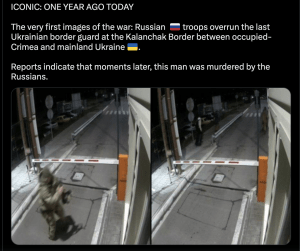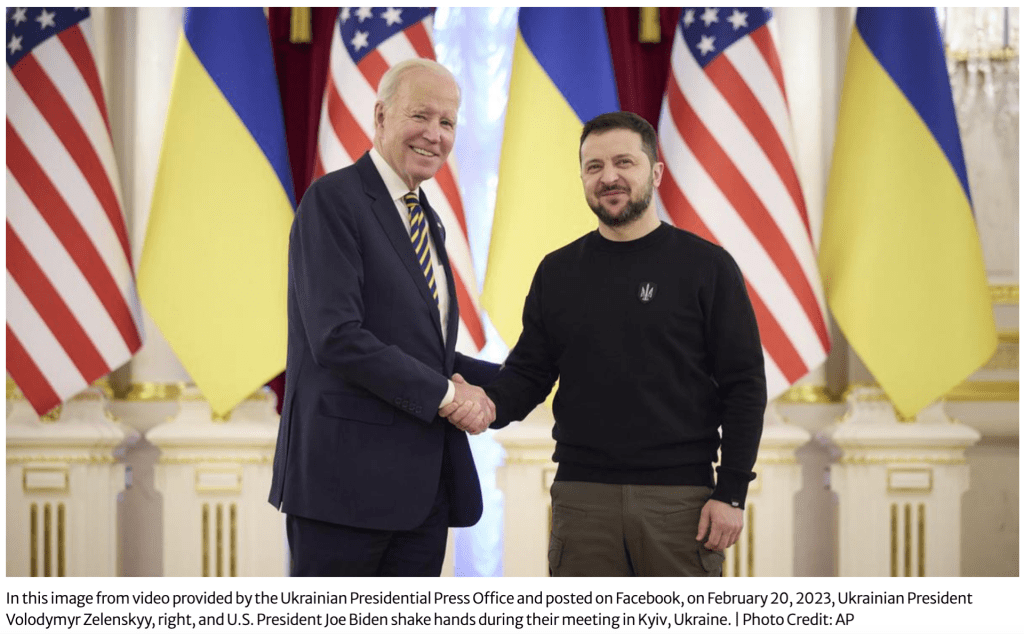Russia’s War In Ukraine: One Year Later
Assessing effects and the future of Ukraine and Russia one year after invasion.
February 24, 2023
Alexander Donlon, ‘23 International Affairs, Madison Center Democracy Fellow,
Adrik Bagdasarian, ‘23 International Affairs, Woodson Martin Democracy Fellow
Dr. Kara Dillard, Interim Associate Director, Madison Center for Civic Engagement
The early morning hours of February 24, 2022, were quiet but tense. Citizens all across Ukraine were waking to another morning of uncertainty. Since Russia’s initial offensive in 2014, which annexed Crimea from Ukraine, there has been a persistent sense of precariousness for the future of Ukraine. Despite international condemnation from various organizations and governments, punishing sanctions, and severing diplomatic ties, Russia has generally faced little international military opposition in response to its actions against Crimea. Many believe this was due to overall weak resolve from the international community and an unwillingness to provide military aid to Ukraine. However, nearly eight years later, another Russian offensive has been met with an entirely different response.
Just days after the closing ceremonies of the 2022 Beijing Winter Olympics, Russian President Vladimir Putin declared a “special military operation” in neighboring Ukraine, which would begin both a new offensive and a continuation of the 2014 Russo-Ukrainian War. The official declaration of war came after a month of increased tensions, including Russian military demonstrations in Belarus and isolated fighting in pro-Russian areas of Eastern Ukraine. Since October, U.S. intelligence had been publicly warning its European and Asian allies that Russia was massing large armies on its border with Ukraine with the goal of seizing Kyiv, while both publicly and privately warning the Kremlin that there would be “severe consequences” for invading.

Unclear still is how many lives have been lost in the war so far. Russia has downplayed its war casualty, stating only 6,000 Russian troops have been killed in action, while Ukraine’s intelligence reports the number closer to 145,850 deaths. Russian news agencies have reported 175,000 Ukrainian troop deaths, but advisers close to Ukrainian president Volodymyr Zelenskyy report closer to 10,000 have died. As we wrote about in our primer on Russian and Iranian disinformation, it’s difficult to discern the true number of casualties.
Russia’s declaration of war one year ago has sparked an ongoing conflict resulting in a global energy crisis, a humanitarian crisis, a devastating loss of human life, and a reworking of how Western nations support democratically-governed countries.
Impacts Of The War So Far
The reshaping of global energy markets
Massive disruption of the global energy market was one of the first major problems resulting from Russia’s invasion. While energy security became an urgent concern to the rest of the world, it became an especially paramount issue to Europe. As late as 2021, Europe imported over 80% of its natural gas, with half coming from Russia. As part of a set of punishing sanctions on Russia, the E.U. the importation of crude oil and refined petroleum products, coal and other fossil fuels, with limited exceptions. Russia retaliated and reduced the export of liquified natural gas, and Ukraine is a crucial transit country for Russian natural gas exports to the rest of the continent. Once Russian gas giant Gazprom slowly decreased gas exports through key connecting pipelines, European countries scrambled to find alternative energy partners. Germany, whose energy consumption was more than half comprised of Russian exports, was hit significantly. In the U.S. gas prices, already rising due to inflation, skyrocketed in the Spring months to over $4.00/gal national average. The EU hopes to import zero percent of its natural gas from Russia by the end of 2023 and instead is turning back to coal, nuclear power, and LNG imports from other countries like the U.S.
Russia’s military and strategic disasters
While much of the outcome of this war remains undecided, it is clear that Putin’s plan to capture Kyiv quickly did not go according to plan. After seizing land in eastern and southern Ukraine, Putin’s campaign stalled. The unsuccessful campaign is due to dual reasons: the ineptitude of the Russian military and Western financial and military aid to Ukraine, chiefly from the U.S.
Underpinned by outdated equipment and poor logistics, Russia has been at an apparent disadvantage from the beginning. While Russia was previously seen as a global military power, the effect of wide-scale corruption and embezzlement has quickly revealed the deficits of the Russian army. Equipment is often outdated, sometimes not functioning at all, leading to an immense disadvantage when faced with newer, more advanced Western weapons. The New York Times’ blockbuster story on how the war became a catastrophe for Russia documents soldiers going into battle with little food or bullets, without instruction for how to fire and care for their weapons, with either old maps of Ukraine or no maps at all. In communicating with family members back home via personal cellphones, soldiers reveal their locations to intelligence agencies listening in. Russia failed in the early days of the war to knock out Ukraine’s air defense and didn’t anticipate Ukraine’s air force moving its air fleet to smaller, newer bases. Using those old maps, Russia’s missiles struck old military bases without impact. The lack of air cover for Russian troops proved disastrous. Entire regiments of Russian troops were eviscerated by Ukrainians using shoulder-fired anti-tank weapons while hiding in forests. Russia is also short on leadership and logistics, as many of Russia’s top generals have been killed in Ukraine. Moreover, Putin continues surrounding himself with yes-men who cannot dissent from his command.
To confound things even more, Russia is losing men at an unprecedented rate, leading to mass mobilizations of troops, mostly conscripts, that have little experience on the battlefield, poor equipment and rations, and ultimately low resolve. For these reasons, Russia has underperformed on the battlefield at a humiliating rate, with Western intelligence warning that the country has already suffered between 40,000 and 60,000 deaths, with some higher speculations of more than 200,000 casualties. In just one year of fighting, this number remains unsustainable if Russia is to achieve some sort of victory in Ukraine.
A growing global-to-local humanitarian crisis
Another effect the conflict had on the international community was the mass forced migration from Ukraine. According to the United Nations, as a result of the conflict, more than 8 million Ukrainian citizens have fled the country, and 5.9 million have been internally displaced. The forced migration of Ukrainians has led to significant humanitarian concerns, with many refugees facing food, water, and medical supply shortages. Many displaced people have also lost their homes, possessions, and livelihoods, with limited access to jobs or income. Despite most refugees fleeing to Europe, the UN estimates that between 100,000 and 300,000 Ukrainian refugees have fled to the United States.
Russell Leary, executive director of NewBridges Immigrant Resource Center in Harrisonburg, Virginia, has worked with Ukrainian refugee families in the Harrisonburg community and estimates that nearly 300 have sought refuge in the small sanctuary city. In his recent assistance to Ukrainian refugees, Leary noted in an interview with the Madison Center for Civic Engagement that many “have struggled to find housing, as Harrisonburg is already at nearly max occupancy for rental homes and apartments.” Despite the housing shortage in Harrisonburg, Leary shared that “the [Harrisonburg] community has responded to their need in many ways, providing food, clothing, furniture, and financial donations,” which has been bolstered by a strong network of local organizations, including Village to Village, Church World Service, The Central Shenandoah Health District, Bowl of Good, and several local church congregations.
The war at one year: What developments should we expect?
President Zelenskyy has pledged a path to victory for Ukraine in 2023, calling the past year Ukraine’s “longest day.” In an address to Ukrainian citizens and supporters, Zelenskyy said that “every tomorrow is worth fighting for.”
Despite Russia’s poorly performing military, there are still several reasons why they must still be considered a dangerous threat to Ukraine and the world. First, Putin has remarkably maintained control over his country, using a combination of fear and disinformation to keep his population in line and in the dark. As long as Putin oversees Russia’s power, he remains a threat to international security.
Second, while Western sanctions have hindered Russia’s economy, they have not rendered Putin helpless. Sanctions have made it harder for Russia to manufacture high-tech weaponry; however, Putin continues to make deals with his allies, including Iran and North Korea, to supply him with lethal force to wage war in Ukraine. Notably, the Iranian Shaheed Drone has had a significant impact on the war. Furthermore, while China has abstained so far from supplying lethal force (this may soon change according to top U.S. officials), they have engaged in increased trade with Russia, helping Putin to dodge the economic effects of sanctions. Because of Russia’s close partnerships with key American enemies, sanctions have not significantly impacted Putin’s ability to wage war on Ukraine.
Third, Russia has been able to rely on the Wagner group, a privately contracted military group, to make gains in eastern Ukraine. The Wagner group, which has been more than 50,000 strong, has been able to effectively mesh a large number of recruited convicts with well-trained, privately contracted soldiers. Much to the fault of their strategy, the Wagner group has seen significant casualties. Nonetheless, their manpower poses a threat.
Finally, Russia’s utter disregard for human life and deliberate strategy to inflict as much civilian harm as possible poses an immense threat. Russia has made indiscriminate civilian shelling a significant part of its offensive, and because of this, nearly 19,000 civilians have been either killed or injured. As Russia’s military continues to stall on the battlefield, more civilian lives are at risk as Russia further commits itself to a strategy targeted at civilians.
On the battlefield, there is fighting all along the Ukrainian/Russian front in eastern Ukraine. The city of Bakhmut, where victory would signal a moral boost for both sides, has seen most of the fighting as of February 2023. Russia has been unable to take the city despite Putin’s wishes to take the city before the war’s anniversary. Furthermore, Ukraine has been able to successfully repel Russian advances throughout the winter elsewhere. Moreover, it is currently doubtful that Russia has the capability to push deeper into central Ukraine due to prior losses in manpower and equipment.

To continue Ukraine’s momentum, President Zelenskyy continues to rally for more Western aid to reinforce Ukraine’s defensive position as the war remains a stalemate along the front in eastern Ukraine. While Ukraine has not received the total military capacity from the United States and NATO allies that it had hoped, the U.S. has still supplied large quantities of ammunition and weapons vital to Ukraine’s defensive dominance. Recently, Ukraine’s NATO allies agreed to finally send advanced tanks to the battlefield, with a wait time of just three months. President Biden’s surprise, secret trip to Ukraine in mid-February 2023 was as much a stand of support for Ukraine as it was a gesture of defiance of Russia and Putin. “And Ukraine stands. Democracy stands. The Americans stand with you, and the world stands with you,” Biden emphasized while standing next to Zelenskyy.
Unfortunately, an end to this conflict which has caused immense destruction is not in sight. While Putin ramps up his efforts to avoid a total loss, the war, from here on out, will require even more resolve from Ukraine’s allies, specifically with critical aid to the country. However, international support for Ukraine is a silver lining. Not only is much of the world ready to condemn Russia for its war of aggression and war crimes in Ukraine, but allies have remained steadfast in what is a conflict between the protection of democracy and the rise of autocracy.
Extra Reading:
Russia-ukraine-offensive-putin-donbas-bakhmut
Experts-react-factors-shaping-russia-ukraine-conflict-2023
https://wwwrussian-death-toll-ukraine-tens-of-thousands-western-intelligence-2023-2.cnbc.com/2023/02/17/russia-ukraine-live-updates.html

Recent Comments